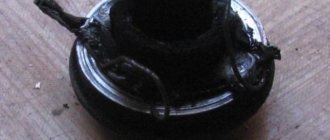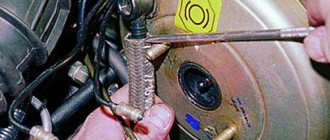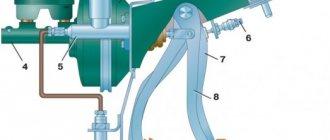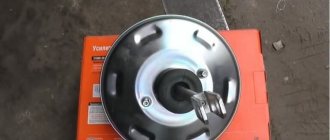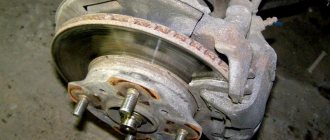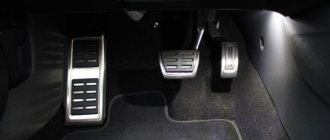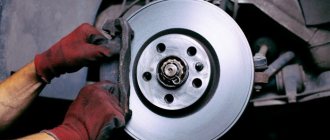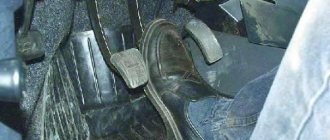Device
Hydraulic brakes are installed on the machine and operate generally reliably. They are double-circuit and have a diagonal distribution. That is, if one part suddenly fails, then braking by another circuit is possible. For the sake of safety, the VAZ 2110 brakes operate diagonally, one circuit is the right front and left rear wheels, the other is also diagonal.
This device allows you to brake efficiently (without skidding and other troubles) even in the event of a malfunction, if the brakes in one of the circuits are lost.
Let's consider the design of the brake system. The hydraulic drive includes a vacuum booster, as well as a dual-circuit regulator that creates pressure in the rear brakes.
The brake caliper design is described in this article:
In addition, the hydraulic drive is equipped with pipelines divided into two circuits, hoses and brake mechanisms that provide braking to the front and rear mechanisms.
The hydraulic drive is activated by a pedal located in the cabin (middle). Here are the main components of the hydraulic drive:
- Vacuum booster.
It is designed in such a way that it creates pressure on the master cylinder piston, and thus causes braking; Vacuum brake booster - Pressure regulator drive.
It is through it that the working brake fluid flows to the rear brake mechanisms; Brake pressure regulator drive - The pressure regulator itself.
Already from the name it is clear that this device is responsible for the force of pressure, its decrease or increase. He does this depending on how loaded the rear axle of the car is; Pressure regulator - Main cylinder with pistons, equipped with a reservoir.
The filler neck of the tank is equipped with an emergency fuel level sensor; Master brake cylinder - Brake mechanism for the front wheel.
Its main parts are the disc, pads and wheel cylinders. The mechanism also provides an indicator to prevent complete wear and malfunction of the linings; Front wheel brake - Brake mechanism for the rear wheel. Unlike the front disc brakes, the rear ones are drum brakes. This is the factory configuration. However, many car owners believe that their device does not provide high-quality braking, and change them to disc ones.
The brakes require attention. Without waiting for the warning light to come on, indicating a critical level of fuel fluid or wear of the linings, and even more so, without allowing the brakes to completely disappear, you need to carry out preventive checks.
Particular attention should be paid to all connections and hoses, since the “escaped” brake fluid will not make it possible to brake, and from here it’s not far from tragedy.
What to do if there is no one to help
It is not always possible to pump the brakes with 4 hands, so manufacturers came up with an aerator. It is sold in all auto stores and markets. The cost of this special device does not exceed 200 rubles, but it will help you bleed the brake system at any convenient time.
If you don’t have time to look for the right device, you can create pressure in the system using a regular wheel. Connect the chamber valve to the expansion tank for the brake fluid. Raise the side of the car to be repaired and open the bleeder fitting. Install the aerator and unscrew the wheel chamber nipple, wait until liquid begins to come out of the system.
If you have a compressor, you can use it instead of a wheel. In this case, pumping will be more effective. When doing the work yourself, you need to monitor the system and remove pressure from it in a timely manner.
Alarm Signals
The following symptoms are quite unsafe, please note:
- If the brakes are completely gone, then it’s clear that you can’t go any further, even to a service station! If independent repairs on site are beyond your capabilities, or simply impossible, you need to call a tow truck;
- When braking there is a strong vibration, especially felt in the steering column. You press the pedal, and it’s just hard to hold the steering wheel in your hands. There can be several reasons for vibration: Many argue that vibration can occur due to the fact that there are non-ventilated disks. Their design is such that they really don’t like it when braking occurs in the rain, or even right in a puddle. No repair will help here - you need to replace the disks with ventilated ones; Vibration is also possible if there is a malfunction in the rear drums. If upon inspection you find dark spots on the working surface, this indicates uneven wear. The vibration is usually very strong. Such drums need urgent repairs, and possibly replacement with disc brakes; Check the front brake discs for deformation. At the same time, vibration is also observed.
- The brake pedal is too tight. There may also be several reasons for this: A clogged air filter for the vacuum booster may cause the pedal to become stiff; Check the vacuum booster itself. Its possible malfunctions are destruction of the diaphragm, tip, sticking of the check valve, damage to the hose connecting the intake manifold to the amplifier. In all these cases, a stiff pedal syndrome may occur, and repair of any of the indicated faults is necessary; Also, the pedal may become stiffer as the pads wear, check them too.
- Hisses when you press the brake. If it hisses exactly when you press the pedal, you need to urgently check the vacuum booster, and then decide whether it needs repair or replacement. But if it hisses when you release the brake, then this is a normal phenomenon. Unless, of course, the hiss is too obvious.
This material will help you replace the rear brake pads yourself:
Swelling of rings in cylinders.
The condition of the brakes largely depends on what kind of brake fluid is used during operation. If it is a product of a well-established company, the vehicle is rarely damaged or disabled. But if the fluid is of poor quality, one or more cylinders may not function well due to their O-rings swelling. The same thing happens when fuel and lubricant gets on the ring.
Previously, especially in the era of the Soviet automobile industry, the car owner sooner or later had to sort out the working cylinders. Such an activity was long and burdensome even for professionals. But now hardly anyone will do this if the vehicle is faulty. From the point of view of saving time, it is much easier to change them, and at the same time the brake fluid. However, you can avoid unnecessary financial costs if you use high-quality, albeit expensive, liquid from the very beginning, since repair costs are always higher.
Finalization
Many, believing that the brakes are bad and repairs do not help them, decide on significant alterations and tuning. For example, tuning the brake system of a VAZ 2110 may include replacing the rear drum mechanisms with disc ones.
It is especially important to know here that braking of the rear wheels should be softer and occur a little later than the front wheels to prevent skidding.
Another possible idea for tuning is replacing the vacuum booster as well. Instead of standard ones, they are installed from Lada Priora. This usually helps, first of all, in that vibration is not felt and the pedal works with optimal force.
And do not forget - after each intervention in the brakes, they need to be pumped.
You can read more about replacing the vacuum brake booster in this material:
The most important organ in any car is the brake system. It must be in perfect condition, because our lives depend on it. One of the main indicators of the efficiency of this unit is the pedal, which must always differ in the state of pressing that is familiar to the foot. This rule cannot be neglected and if the slightest changes occur, adjustments or repairs must be made immediately. Below we will look at what needs to be done when the brake pedal becomes hard, does not press at all, or grabs at the very end of its stroke. We will also pay attention to the issues of self-diagnosis and study all the reasons for the failure of this mechanism.
Cotton brakes VAZ 2110
It's easy and interesting to communicate here. Join us!
I hope the rear was pumped when the car was on the ground? Well, or at least rested on the racks with a bridge? If the rear wheels were hanging out during bleeding, it is equivalent to the fact that there was no pumping!
If it's not running, press the brake harder and start it, if the pedal doesn't go any further, the vacuum leaks
It is necessary to bleed the master cylinder and brake lines on the wheels. If the problem persists, the problem is in the GTZ - change it or buy a repair kit and rebuild it
Bleeding the brakes on any car is carried out not only after repairing system elements, brake cylinders, replacing line elements, and seals. From time to time there is a need to remove air from the system after the fluid boils, airing when the fluid level in the tank drops, a leak, and also after any depressurization of the brake line . The process of bleeding the VAZ-2110 brakes is simple, the work does not take much time, and in addition, you can do everything yourself if you cannot find an assistant.
Causes of brake pedal failure
Changes in the degree of effort to press the pedal occur due to a number of design violations, which can be either universal for all types of cars, or defects exclusively in certain models or series. We will consider a list of the main problems that can be called typical for modern and Soviet cars. As a rule, failure of the brake pedal is a consequence of a malfunction of the vacuum booster or brake master cylinder. A detailed analysis of the performance and changes in the brake system will reveal the true source:
- The VU air filter is clogged. This element is not cleaned. If a significant amount of foreign substances gets inside, which affects performance, it is necessary to replace the amplifier with a new analogue.
Mechanical damage to the VU valve body. With minor defects, the mechanism begins to jam, which affects the force of pressing the pedal. Such a breakdown, unfortunately, cannot be repaired, but requires replacement of the amplifier.
Damage to the VU diaphragm. A sign of the presence of this defect may be extraneous sounds when the braking system is activated. The damage is corrected by replacing the amplifier.
The tip of the VU is faulty. This reason can also cause the brake pedal to catch at the end of its stroke. To fix the problem, unlike previous breakdowns, replacement of the main element is not required. It is enough to install only a new tip.
- The check valve does not work or gets stuck - this can be eliminated by replacing this mechanism. Depressurization of this segment leads to fuel entering the cavity of the amplifier. In the future, this disables the entire unit. As a result, you need to change the control unit complete with the check valve.
Damage or loosening of the hose connecting the intake manifold to the intake manifold. In the first case, the rubber tube needs to be replaced, and in the second option, the fastening clamps will have to be tightened or replaced if damaged. This reason is the most common and requires regular monitoring and inspection of fastening reliability. The condition of the hose must be checked regularly. It is made of a special polymer, which becomes rigid when cooled, but after turning on the engine and warming up, the material becomes flexible. Because of this, its throughput is reduced. As a result of this problem, problems arise in the operation of the brake pedal. To avoid this problem, you need to purchase high-quality parts with specific thermal parameters.
Swelling of sealing rings in cylinders. If the brake pedal is not pressed, you should immediately check the condition of the elastic seals. Most often this happens due to gasoline and oil getting inside the components or using low-quality brake fluid. Depending on the degree of damage, seals and low-quality brake fluid are replaced with an analogue recommended by the manufacturer.
Preparing for work
Pumping will not be effective unless you first carry out a number of preparatory measures to prepare the system for intervention:
- Check the amount of brake fluid in the conservator tank. It should be at the maximum level. If necessary, add more until the level reaches maximum.
- Prepare a clean plastic container in which to place some brake fluid.
- Take a hose whose diameter is equal to the size of the brake fittings. It must be of sufficient length.
- If you have placed the car on jacks or a special lift, then you need to insert a flat-head screwdriver between the piston and the plate. This technique will help you block the pressure regulator.
- Loosen the fittings slightly.
One of the most important recommendations is to have an assistant to carry out the work. This could be any person, even those who do not understand car repair issues. He has a simple job to do.
Diagnosis of brake pedal operation
The correct state of pressure for the leg can be viewed from different aspects. However, there can only be one answer. In an effective and fully functional system, the pressing force always remains the same, there are no exceptions to this rule. It should be understood that uncharacteristic sounds are also a sign of failure. They arise in the process of mechanical action on the lever, while the pressing force can remain unchanged. In such cases, you need to contact specialists or carry out independent repairs.
Methods for diagnosing faults without special equipment
Start the power unit, this will create a vacuum in the brake system. Then press the pedal. If it is still hard, the amplifier or hose is faulty.
Turn off the engine and, without pressing the brake, wait 4-6 minutes. After the time has passed, press the pedal. If the lever has not lost its rigidity, the VU valve is most likely faulty.
With the engine off, depress the pedal several times. These actions will relieve the vacuum in the brake system. Press the pedal to its extreme position and start the engine. If the pedal goes down a little, then there are no problems with the VU. The latter method allows you to most effectively test the performance of the amplifier. Diagnosing depressurization is very simple. A sign of this problem is the unstable operation of the engine, as they say it “troubles”. The reason for this is air entering the intake manifold. During the depressurization process, the air-fuel mixture becomes sharply leaner. If the pedal does not press when the car is running, first of all you should check the reliability of the connections. A sign of this breakdown is also a characteristic hissing sound from the vacuum booster when the engine is running.
The information described above will help in solving the problem with the “hardening” of the brake pedal. If you find any changes, do not delay repairs and fix the damage as soon as possible. You must always remember that the safety of all road users depends on the effectiveness of the braking system.
The article will talk about what to do when the brake pedal becomes too soft or, on the contrary, too tight. When the brake pedal stops working normally, becomes harder or softer, the driver’s concern is completely justified. This means that there are some malfunctions and the brake system needs to be repaired. And you can’t put it off.
If the brake pedal suddenly becomes tight, there are several reasons for this, although they are not necessarily typical or traditional for all models and types of brakes.
Personal experience of car owners.
Alexei:
“I am a driver with little experience, so it was very difficult for me to independently determine the cause of the pedal hardness. I couldn’t even figure out how to remove this or that part in order to diagnose specific problems. In the end, I took my Audi A6 to a service station. The craftsmen working there determined the nature of the damage without even removing the units. Correct diagnostics helped me significantly save on repairs.”
Ivan:
“When the amplifier of my VAZ 2114 broke down, I verified that it was faulty in a simple way. To do this, the hose is removed and the amplifier is turned off. The presence of a vacuum when starting the engine indicates that the “vacuum valve” is faulty.”
Novel:
“The vacuum booster and cylinders are very difficult to diagnose. The best vehicle diagnostics can be provided only by those car services that have pressure gauges.”
The main reasons for a soft or stiff brake pedal and methods for solving them
In most cases, the brake pedal becomes soft due to problems with the master cylinder or vacuum booster. It is much cheaper and easier to systematically diagnose brakes, so as not to spend money on repairs later. Because brakes fail at the most inopportune times, remember this.
The brake pedal must be pressed with increased force for several reasons:
- the air filter of the vacuum amplifier is clogged. In this case, the air filter must be replaced; · the valve body in the vacuum booster is stuck, there is only one way out - replace the vacuum booster;
- it may be that the diaphragm in the vacuum amplifier is damaged, then the amplifier needs to be changed;
- malfunction of the tip of the vacuum booster - you need to change the tip;
- the check valve in the vacuum booster does not work or is stuck, so fuel enters the cavity of the vacuum booster. In this case, it is necessary to change not only the vacuum booster, but also the check valve;
- The hose that connects the vacuum booster and the intake manifold is damaged, or the hose fastening in the fitting is loose.
You will need to change the hose or tighten the mounting clamp. If we talk about the vacuum booster hose, then you need to constantly monitor its condition. Especially in winter. The hose will be quite stiff until it is warmed up. The brakes work fine. The hose will heat up after the engine has been running for a short time, and it will become more elastic. If the delamination of the hose is not noticeable, its throughput will decrease.
There may be problems with the brake pedal;
O-rings in wheel (working) cylinders may swell. This can happen if fuels and lubricants get into them or if low-quality brake fluid is used. Brake fluid and wheel cylinders should only be replaced with those recommended by the manufacturer.
Why is the pedal soft?
Due to certain problems, the brake pedal frog may also be faulty. Such a nuisance can come “in full” along with other related ones. Very often, a soft brake pedal is the direct cause of a significant deterioration in vehicle control.
A soft brake pedal may be a simple feature of the model. The cause of malfunctions may be air entering the relevant system. Everything is corrected by bleeding the brake itself in order to protect it from possible problems.
In turn, air can enter the system in many ways, and if problems appear with it, then most likely it is to blame. The pipeline may well lose its seal or even burst in this case. Due to a breakdown of the master cylinder, in which the brake fluid begins to boil, corresponding problems also arise. An accompanying failure is often jamming of the piston. It is advisable to diagnose the cylinders and check the brake fluid. It would also be a good idea to do a complete health check of the machine to determine if there are any hidden problems, if any.
Methods for checking a vacuum booster
There are several ways to check the vacuum booster. First you need to start the engine. A vacuum will be created in the system. Next they press the brakes. If the brake pedal is hard, then there is a fault in the hose or booster. You need to turn off the engine and wait 5 minutes, but do not apply the brakes.
To specify the malfunction, you need to press the pedal. If it continues to be hard, then in most cases there is a problem with the vacuum booster valve.
There is another way. The engine must be turned off. To relieve the vacuum in the brake system, press the brake pedal several times. Then the engine is started, but the brake pedal is not released. If the pedal goes down, then there is no problem with the amplifier.
The second problem is the soft brake pedal. This may indicate several malfunctions at once. More precisely, there are several reasons why the brake pedal can become soft. Soft brakes mean the brake pedal sinks.
Results
Other problems with the brake system are also possible - wear or oiling of brake pads, discs and drums, jamming of wheel cylinders and caliper guides. But one thing is clear - the braking system requires serious attention. Regular inspection, prevention and replacement of the vehicle, immediate response to problems and timely troubleshooting will allow you to feel more confident on the road and avoid many unpleasant and dangerous situations.
Use only high-quality spare parts, and in order not to run into fakes, purchase them from trustworthy stores.
Causes of soft brakes
- The brake system is “aired”. It will be necessary to remove all the air, that is, bleed the brake system. The cause of air ingress may be a depressurization of the system or a low level of brake fluid in the expansion tank;
- there may be a malfunction in the master brake cylinder;
- the last option is problems with the working cylinder. Such problems may be due to boiling of the brake fluid or jamming of the piston. In this case, you need to replace the brake fluid or repair the brake cylinders.
Hissing when you press the brake pedal is one of the most common problems encountered in the operation of both domestic and foreign-made cars.
The thing is that most drivers react sensitively to various sounds that accompany the operation of car mechanisms. An exception is the case when a hissing sound is heard when you press the brake pedal.
But it is not always worth panicking - especially in cases where the hissing of the brake pedal when pressed does not in any way affect the efficiency of the braking system. In order to understand the nature of this sound, let's take a closer look at the operation of the vacuum brake booster.
Brakes are one of the main components of any car. And if, when you press the brake pedal, you hear hissing, creaking, the structure itself fails or, on the contrary, is too hard, you need to urgently correct the situation, do not delay or shelve possible repairs. Or at least diagnose the causes of trouble. Knowledge and understanding of the problem leads to its fastest resolution, and timely correction can save you from unforeseen situations on the road.
Problems when paying with bank cards
Sometimes difficulties may arise when paying with Visa/MasterCard bank cards. The most common of them:
- There is a restriction on the card for paying for online purchases
- A plastic card is not intended for making payments online.
- The plastic card is not activated for making payments online.
- There are not enough funds on the plastic card.
In order to solve these problems, you need to call or write to the technical support of the bank where you are served. Bank specialists will help you resolve them and make payments.
That's basically it. The entire process of paying for a book in PDF format on car repair on our website takes 1-2 minutes.
Hello everyone, so the other day I began to notice that the brake fluid began to rapidly decrease from the reservoir, and the brakes became less effective, I decided to open the drums and it was clear that one cylinder was completely bad, I decided to change it, I came home from the night, slept and went to work, took off the wheel, I can remove the drums without any problems, this is generally a huge +, less problems))
Next, I decided to start right away by loosening the cylinder mount)
I filled it with water and started tapping the bolts,
I managed to tear them off without any problems, but everything was wrong with the tube, I don’t have a special key, I had to carefully tear it off with a 10-open-end wrench and tap it, and after about 5 minutes of such manipulations, things started to work,
Now since the pads are in the way and I was going to change them anyway, we remove them. The most difficult thing is the top spring, and I managed the rest with wiring, I passed it through the coil and bent it very conveniently)) When I removed all the springs, I removed the cotter pin and washer Well, we remove everything and throw off the cylinder, quite a bit of brake fluid leaks out)
The replacement was simple, I removed it, and the main thing is to do everything carefully. All cylinder installed
Then we put everything back together, I installed new pads, everything is just the main thing, then tighten the upper spring since it is the stiffest, and that’s it) we put on the drum and drive on, the main thing is then to loosen the handbrake, which I haven’t done yet) and bleed the brakes. And now my feil When I did it on the other side, things went faster, but I made a mistake! Having installed everything, I went to get cutting wheels and other small things; at this time the brake fluid on the left rear wheel was leaking and the cylinder was squeezed out, due to my carelessness! I didn’t put the block in the lower groove, and thus it turned out to be fucked up and I drove off like that, I didn’t realize it right away, the brakes disappeared, well, when approaching the house, in the end I had to disassemble everything again and walk to the store for a new cylinder, well there’s a 24-hour Ladovsky store nearby spare parts)) in the end I installed everything, bled the brakes now the fire is just not usual)) My problem so don’t rush) Good luck to everyone on the roads and don’t break down
The level of hissing when you press the pedal - which is normal and which is not
There is a category of drivers who listen very carefully to every slightest squeak or sound and try to hear signs of a breakdown. A car is a mechanical vehicle that contains a sufficient number of components and mechanisms that can create a small permissible noise level. You shouldn’t listen too much to this and go straight to the service center, where, with a lot of persistence, they will definitely find the problem and offer to fix it. The brake pedal, when pressed, in most cases emits a slight hiss.
It must be said that you need to check the brakes for various noises while the car is running. In this case, windows and doors should be closed, and all devices that can make additional noise should be turned off, if possible. A small noise level in the cabin may occur due to the design of the brake system, which, as a rule, has two vacuum chambers. When you press the brake pedal, different pressures arise in them, which is why a slight hiss occurs. If it is minimal and almost imperceptible, then there will be no problems when braking.
If at idle, when you press the pedal, you hear a loud, choking sound or a strong hiss, and it is pressed tightly, then you need to look for problems. First of all, the vacuum booster is checked. A stiff pedal is not a sign of a breakdown of this part, especially in severe frost, but, coupled with hissing, it indicates the need to check it.
The brake system is constantly used by the driver, so the elements of the system are under load. Whatever driving style the driver preaches, over time it is necessary to check the brakes for serviceability. This will ensure the safety of all road users.
The vacuum amplifier has a diaphragm, which over time, like any rubber material, begins to burst and crack. This does not allow it to fully fulfill its functional purpose - to pump up the necessary pressure. The intake vacuum can also fail, but more often this is the first option.
Scheme for pumping brakes on a VAZ-2110
The brake system of the VAZ-2110 has two circuits operating in a diagonal pattern. This dictates the procedure for removing air from the system. When performing work, it is necessary to follow the following pumping sequence:
- Right rear wheel.
- Front left.
- Rear left.
- Front right.
The procedure for bleeding the brake system of the VAZ-2110 and modifications.
Necessary materials
Before you start bleeding, you need to stock up on brake fluid for topping up.
It is important to remember that the liquid must be the same brand that was used previously. If we are not sure what kind of brake fluid is poured into the VAZ-2110 system, it is better to play it safe and replace it completely . Otherwise, when mixing fluids of different types, clots may form in the system, which will damage the brakes.
Also for work you will need a transparent container half filled with liquid, a hose for the fitting about 40-50 cm long, a socket wrench with a cut out segment (union wrench).
Bleeding the brakes with an assistant
An assistant will be needed. Go.
- Open the lid of the fluid reservoir and add it to the maximum allowable mark.
Remove the protective cap from the fitting of the right rear wheel.
Block the "sorcerer" if necessary.
We put the hose on the fitting, connect it to the container and pour brake fluid into it.
We bleed the remaining brake mechanisms in order of priority.
Next, we bleed the brake mechanisms of the remaining wheels, according to the bleeding order.
We pump the brakes ourselves, without an assistant
If you couldn’t find an assistant, no problem.
To bleed the brakes alone, you will need a reservoir cap, a hose and a tubeless tire nipple.
We'll bleed it ourselves, but to do this you need to stock up on an old-style brake reservoir cap, without a fluid level indicator. You will also need a regular nipple from a car camera and a 14mm drill. Drill a hole in the center of the cover and insert the nipple. The device is ready. Let's move on to pumping:
- Add liquid to the tank to the maximum.
- We close the tank with our lid with a nipple.
Screw the cap and gasket onto the tank.
We attach the other end of the hose to the camera nipple.
For convenience, you can embed a faucet from the pneumatic system into the hose.
Vacuum brake booster - how to diagnose a malfunction
Diagnosing a malfunction of the vacuum brake booster is not difficult; it becomes noticeable - when pressed, the brake pedal becomes hard.
But an indirect sign of a malfunction can also be
a change in idle speed when the pedal is pressed
. This is due to a lean fuel mixture caused by “excess” air entering the engine cylinders, which may even stall if the “suction” is too strong.
Most often this is due to damage to the brake booster diaphragm. And it’s not necessarily due to old age - sometimes the sealing rings of the main brake cylinder leak brake fluid, and it gets into the booster housing.
Some car owners manage to rebuild the brake booster themselves - they even sell repair kits for domestic cars. But, in general, this is a thankless task - the body of the “vacuum generator” is non-separable, and not everyone can carefully and tightly connect its parts.
In addition, the operation of the brake system is also affected by adjusting the protrusion of the “vacuum rod” from the housing - incorrect adjustment can reduce the efficiency of the booster or cause incomplete “release of the brakes” of the working brake cylinders. This method of checking the amplifier is common among car enthusiasts - start the engine after squeezing the brake. When starting the engine, the pedal should go to the floor.
The process of removing the vacuum brake booster
If the booster is faulty, the brake pedal will remain “stiff”. In general, hissing associated with the operation of the vacuum brake booster is normal. But in the case when its volume increases for no apparent reason, get ready to replace the vacuum amplifier before it completely fails.
Malfunctions of the "vacuum"
A vacuum brake booster (VUT), or simply a “vacuum booster,” creates in the vehicle’s vehicle the pressure necessary for their proper operation.
If the amplifier is not working well, the pedal simply won't push through. Since the vacuum booster is a rather complex part consisting of many components, a malfunction of any of them can lead to this situation. And since a breakdown of an amplifier component, as a rule, requires its replacement, correct diagnostics will help save the car owner not only time, but also money.
If the filter element of the “vacuum tank” is clogged, it is enough to replace it so that the amplifier begins to function normally again. This also applies to a damaged vacuum booster diaphragm, and problems with the tip or check valve. It is enough to replace one damaged component, and the vehicle will act like new again. It is important to accurately diagnose what exactly needs to be changed.
Sometimes no major replacements are required at all. For example, in a situation where the vehicle is depressurized. The seal can be broken in two cases: either the hose between the “vacuum reservoir” and the intake manifold is damaged, or the clamps are loose. And if in the first case replacing the hose is still necessary, then in the second it is enough to tighten the clamps. This can also be done at a car service center, but the car owner is quite capable of dealing with such a problem on his own.
But it happens that the unsuitability of only one component completely renders the VUT unusable. This most likely occurs in a situation where vehicle malfunctions are ignored for a long time. As a result, a badly damaged valve moves to such a position that it disables the entire “vacuum tank”. An example is damage when a valve jams in the amplifier, and the latter has to be completely replaced. This is one of the most expensive types of vehicle repair.
How to check the vacuum brake booster
The braking system of a car is constantly exposed to loads, and in the so-called aggressive style of driving on city streets, these loads increase exorbitantly. In general, influences of this kind are carried out constantly, even if you prefer a loyal level of speed. Therefore, the brake system must be diagnosed with enviable regularity in order to provide the motorist with the maximum degree of safety. Malfunctions in the vacuum amplifier occur, as a rule, due to the loss of condition of the diaphragm located inside this unit. It may burst or become cracked; there is also natural aging of rubber and loss of its qualities. What's the result? The diaphragm stops forming a vacuum. In some cases, the exhaust valve may also fail.
To check the functionality of the vacuum amplifier, you need to resort to the following manipulations:
In general, each time you press the brake pedal, the engine speed will decrease slightly, however, if the difference becomes significant, it is worth visually diagnosing the hose connecting the amplifier to the power unit. If it has any defects, the collector will become leaky, and accordingly, you won’t have to count on normal mixture formation and the motor will operate unstable. The solution is simple - change the damaged hose.
Handbrake
VAZ 2109 brake regulator
https://youtube.com/watch?v=OC10c-BVUvI
To adjust you will need:
- garage room with inspection hole,
- regular set of keys.
Let's get started:
- Engage forward gear.
- Place stands under the front wheels for safety.
- The rear suspension of the car must be jacked up and supported with reliable supports.
You need to start by checking the lever, which is located inside the car between the two front passenger seats. Raise it two or three clicks. When raised, one click is made, which means the handbrake cable is tightened. This leads to the rear drums being blocked by the brake pads. If more than 8 are done, then the cable is weakened and the handbrake does not work:
- With the handbrake on, go down into the inspection hole.
- Loosen the first lock nut on the equalizer.
- Tighten the second nut so that the cable is in a taut position.
- If necessary, on the contrary, release it.
- Check the operation of the lever. It should respond with two or three clicks.
Then tighten the first nut from the hole, tighten with two wrenches to get the effect of tightening two nuts:
- After this, turn off the parking system.
- Check the rotation of the rear wheel rims.
Make rotational movements with your hands. Their rotation should take place without a jerk, calmly scrolling along the axis of the car. The sound should come out rustling. Consequently, the adjustment of the vehicle's brake system was carried out successfully. The vehicle is ready for continued operation. The brakes can also be adjusted in a car workshop. You can entrust this work to specialists. But the motorist experiences reliability when this work is done independently. A car can be considered technically serviceable when it is independently inspected and repaired. He will never let you down in difficult, dangerous times. In addition, the price of repairs at service stations can be high. When doing the work yourself, you need to carefully watch the video. You also need to study the photos and, if necessary, take them to the repair site. Place it on a rack or in the back seat of the car. If necessary, review them again. Read the instructions for the operation and the location of the necessary structures. Finish the adjustment and check the work done on a free asphalt area.
Air in the brakes how to fix the problem
Brake vacuum is the most common cause. It’s another matter if the texture of the sound differs significantly from the ear. That is, the hissing turns out to be quite loud and, as it were, choking.
At the same time, when pressing on the brake pedal when it is cold, we feel its movement being excessively stiff. And also - the buoyancy of the engine speed (and sometimes it can stall). In such cases, you should pay close attention to the vacuum booster as a possible cause of the problem.
Well, a tight pedal, of course, could also be due to frost, for example, until the main one warms up. But the revs and a fairly strong hiss are already direct indicators that you need to look under the hood! How to check it?
The car's braking system is subjected to constant loads, and with the so-called sporty style of city driving, it is also subject to overloads. This happens regularly even with a measured and leisurely rhythm - there is no escape from this problem. Therefore, this unit must be regularly tested to ensure maximum driving safety for the driver and passengers. So it is with the brake vacuum story. As a rule, problems with its operation occur due to the failure of a special diaphragm located inside the device.
It bursts, cracks, and ceases to perform its duties—to create a vacuum. Sometimes the exhaust valve also malfunctions. Checking the functionality of the vacuum on their own, available to every driver, is carried out in the following way. We start the engine and let it idle for a while until it reaches;
- We turn off the engine;
- Press the brake;
- The first press will be no different from the normal one when the unit is running.
- The pedal must be pressed as much as possible: at the same time, the diaphragm in the amplifier is extended and a vacuum is created;
Release the pedal and press it again. If there is something wrong with the system, then during the second approach a vacuum will not be able to be created, and you will tactilely observe an uncharacteristic small stroke of the pedal itself. These changes indicate a breakdown in the brake booster.
“In 90% of cases, these features are corrected, and the child can study in a regular school”
The initiator of the Dyslexia Belarus project, Valeria Bobkova, says that in the world, according to the WHO classification, dyslexia is classified as a “learning difficulty.” Children with this feature go to regular schools.
“However, there is a local difficulty here: very often such children are misdiagnosed and labeled as having mental retardation.” Then the child, who is absolutely normal in intellectual terms, is sent to a school for children with delayed development. I believe this is due to low awareness on the topic of dyslexia,” says Valeria Bobkova.
According to her, dyslexia is diagnosed at the age of five to seven years, in the UK - from the age of four.
- This is a feature, not a disease. Now there are many technical means that can maximally compensate for the inconvenience for people with such features: special fonts, screen color and text pages. Experts insist that with early diagnosis and qualified correction, these features can be made practically invisible to a person, notes the initiator of the Dyslexia Belarus project.
The photograph is used as an illustration. Photo: Alexander Chuguev
For dyslexics, there are programs to correct this feature. There are free programs on the websites of the International Dyslexia Association or the British Association.
“According to the European Dyslexia Association, in 90% of cases these features are corrected, and the child can continue studying in a regular secondary school,” continues Valeria Bobkova. — In the USA and Great Britain there are special schools for dyslexics. In addition, instead of a written exam, dyslexics often take an oral one; up to 20% more time can be allocated for written tests. The only centers in our country that can hardly be classified as dyslexia correction centers are centers for correctional and developmental education and rehabilitation. This is a government agency that exists in every district. However, there are currently only a few specialists on this topic, which is why there are problems with the diagnosis and correction of dyslexia in Belarus.
How to bleed brakes in 5 minutes - video
Details Published: 06/13/2012 05:26
The study of the most classic defects in the brake system of a car, which are determined using a brake testing stand, continues. Such a component of brake control as a stiff and soft brake pedal (problems and solutions
), includes a pair of states of its position. The first is normal, when the pedal is pressed without noticeable changes, without dips, jumps, without special efforts, and so on. The next two circumstances of the pedal position are unpleasant for the driver, and which cause specific anxiety.
It is said that when the brake pedal becomes stiff or, on the contrary, the brakes are very soft. In this situation, when the brake pedal stops working normally, the driver’s anxiety is justified. This indicates that some defects have arisen and the brake system needs to be repaired. At the same time, without putting it off for a long time.
There may be a couple of reasons why the brake pedal has suddenly become tight, and they are not necessarily traditional and typical for all types and brands of brakes. Despite this, the key, most common causes and ways to eliminate them are considered.
Most of the defects that cause a stiff and soft brake pedal are “to blame”: either the cryogenic booster or the main brake cylinder. Increased effort when pressing the brake pedal is due to the fact that the air filter of the cryogenic booster has become dirty.
In this case, you need to change the air filter; jams the valve body in the cryogenic amplifier. The solution is to change the cryogenic amplifier; The partition of the cryogenic amplifier is broken.
Change the cryogenic amplifier; faulty tip of the cryogenic amplifier - the tip needs to be changed; the opposite valve in the cryogenic amplifier is jammed or does not work, the opposite valve needs to be replaced; The check valve of the cryogenic amplifier is faulty (leaky), which allows fuel to enter the cavity of the cryogenic amplifier.
It is necessary to replace the cryogenic amplifier complete with the opposite valve; the hose that connects the cryogenic amplifier to the intake manifold is broken, or the hose is loosened on the fitting. The hose is changed or the fastening clamp is tightened. Learn more about the cryogenic brake booster hose.
Its condition must be monitored regularly. Especially in the cool season. As long as the hose is not steamed, it remains somewhat stiff, and the brakes work normally. After running the engine for a short time, the hose heats up, becomes more elastic, and its throughput decreases. There may be a problem with the brake pedal.
The sealing rings in the working cylinders are swollen. This can happen due to the penetration of fuels and lubricants into them, or the use of low-quality brake fluid. Repair of working brake cylinders, change of brake fluid to the one recommended by the manufacturer.
Several methods for checking the performance of a cryogenic amplifier:
Start the engine. A vacuum occurs in the system. Then he presses the brake. A hard brake pedal indicates a defect in the amplifier or hose. After stopping the engine, wait about five minutes without pressing the brake.
Specification of the defect. Pressing the pedal. If the pedal remains hard as before, then it is most likely a faulty cryogenic booster valve. With the engine turned off, it is worth pressing the brake pedal a couple of times to remove the discharge in the braking system. Without releasing the brake pedal, you need to start the engine. If the stiff and soft brake pedal (problems and solutions) goes down a little, then everything is fine with the booster.
A soft brake pedal can indicate several defects. Namely, there are a couple of reasons why the brake pedal has suddenly become soft. This effect can also be called: failure of the brake pedal.
A stiff and soft brake pedal (problems and solutions) have traditional causes: “airing” of the brake system. Of course, air must be removed, namely in the form of bleeding the brake system.
The reason for “airing” is possible: once the system is sealed or the brake fluid level in the wide reservoir is too low; defect of the main brake cylinder: defect of the working cylinder, for example, as a result of a stuck piston or boiling of the brake fluid. The brake cylinders need to be repaired or the brake fluid needs to be replaced with new one.
Checking the brake system
VAZ 2109 bleed the brakes
Before starting this work, it is necessary to check the entire system for its leaks. To do this, place the car in a garage with an inspection hole. Carefully clean the joints of rubber hoses and pipelines from accumulated dirt.
You need to clean it carefully - take a rag with your hands, rotate it up and down, clean one side, then the other. After this, you need to make several presses on the pedal, put a load on it or stop it with something else. Necessary:
- Go down into the pit.
- Inspect the connections and the quality of the hoses themselves.
- The joints must be dry.
- If liquid has leaked, then use gentle movements and a special wrench to tighten the connections.
VAZ 2109 bleeding the brake system
- Securely secure the tubes.
- Visually assess the suitability of the rubber hoses; they should not have ruptures in the upper shell or cracks.
Premature damage to rubber hoses can occur due to:
- drainage of mineral oils and grease onto them;
- as well as mechanical damage.
According to the technical specifications of the manufacturer, the hoses must be changed after 150,000 km or after five years of operation of the vehicle. Upon completion of the inspection of the condition of the system from the inspection hole, under the body of the vase, it is necessary to inspect all joints for tightness. This is also done under the hood, in the engine part. In addition, it is necessary to check the fluid level in the master cylinder reservoir. If necessary, the level must be increased to the maximum level.
If the pedal is not pressed
The pedal force is facilitated by a vacuum booster.
The brake pedal is too tight - check the vacuum booster.
This means that if the pedal has become hard or is pressed too hard, the reason is related to it. This could be a simply disconnected or cracked rubber tube coming from the engine exhaust manifold. Or a breakdown of the device itself, most often associated with its depressurization.
In rare cases, breakage or disconnection of the levers may occur - this will be associated with characteristic sounds when pressing the pedal. Sometimes a foreign object or a bent part of the mat gets under the pedal.

